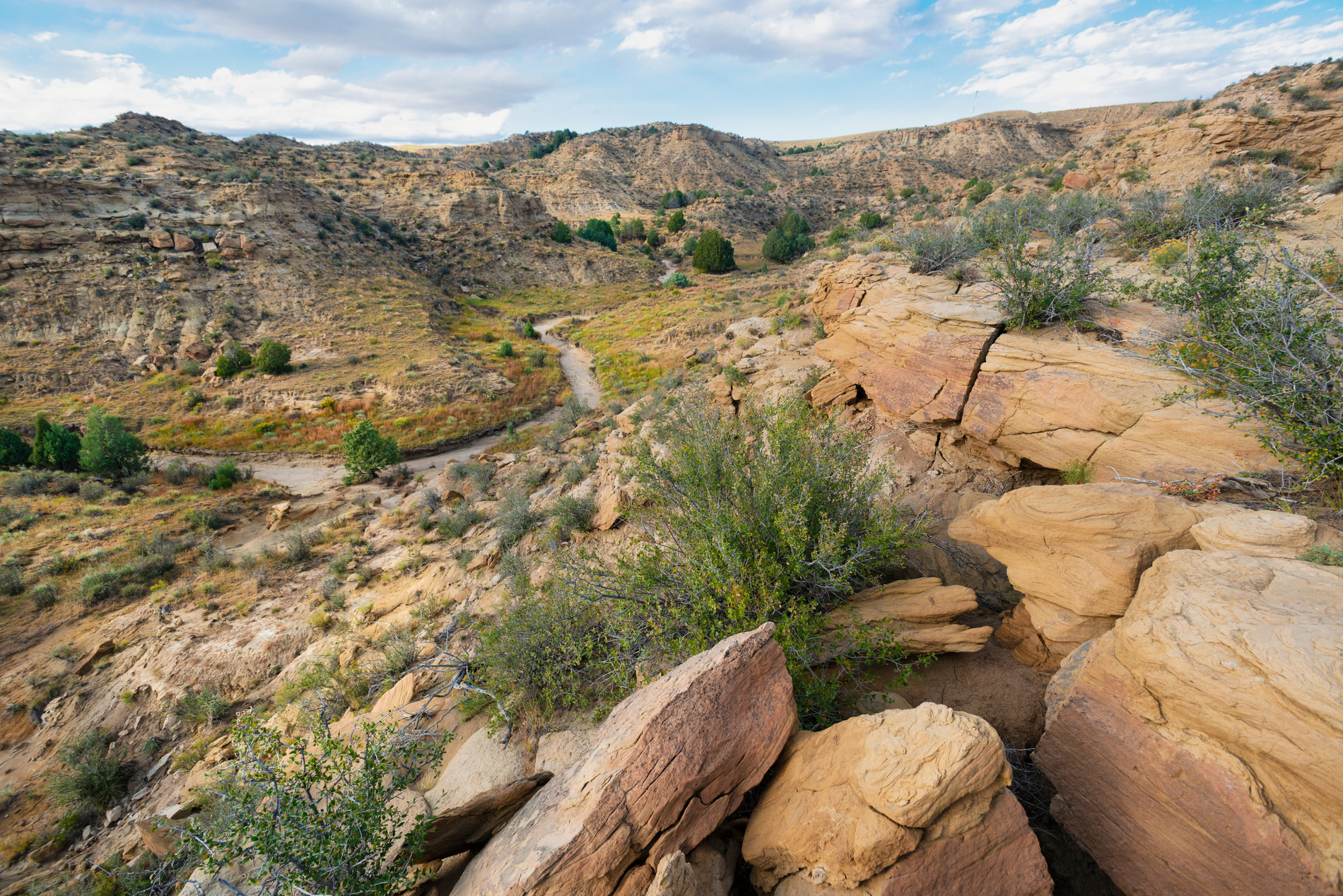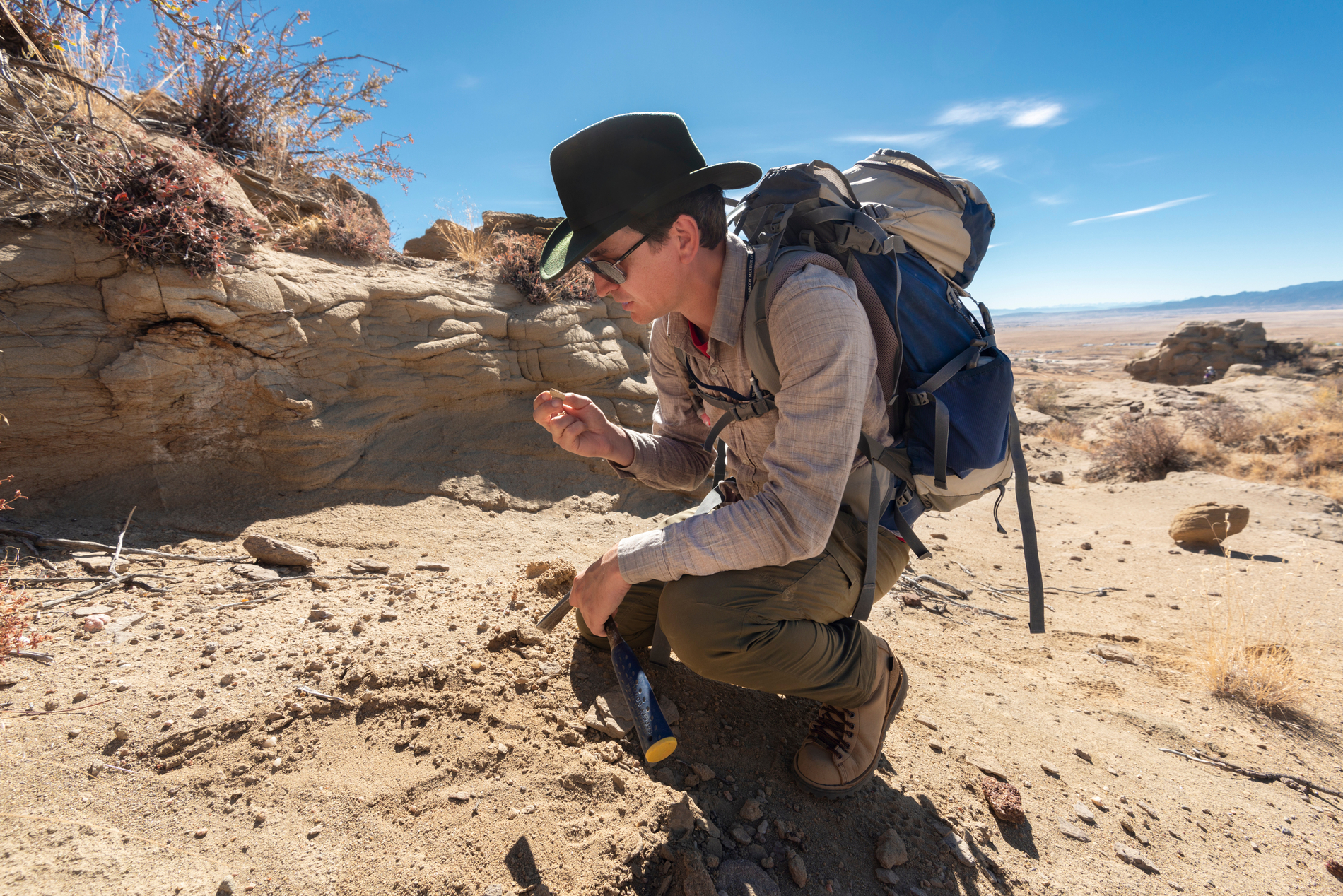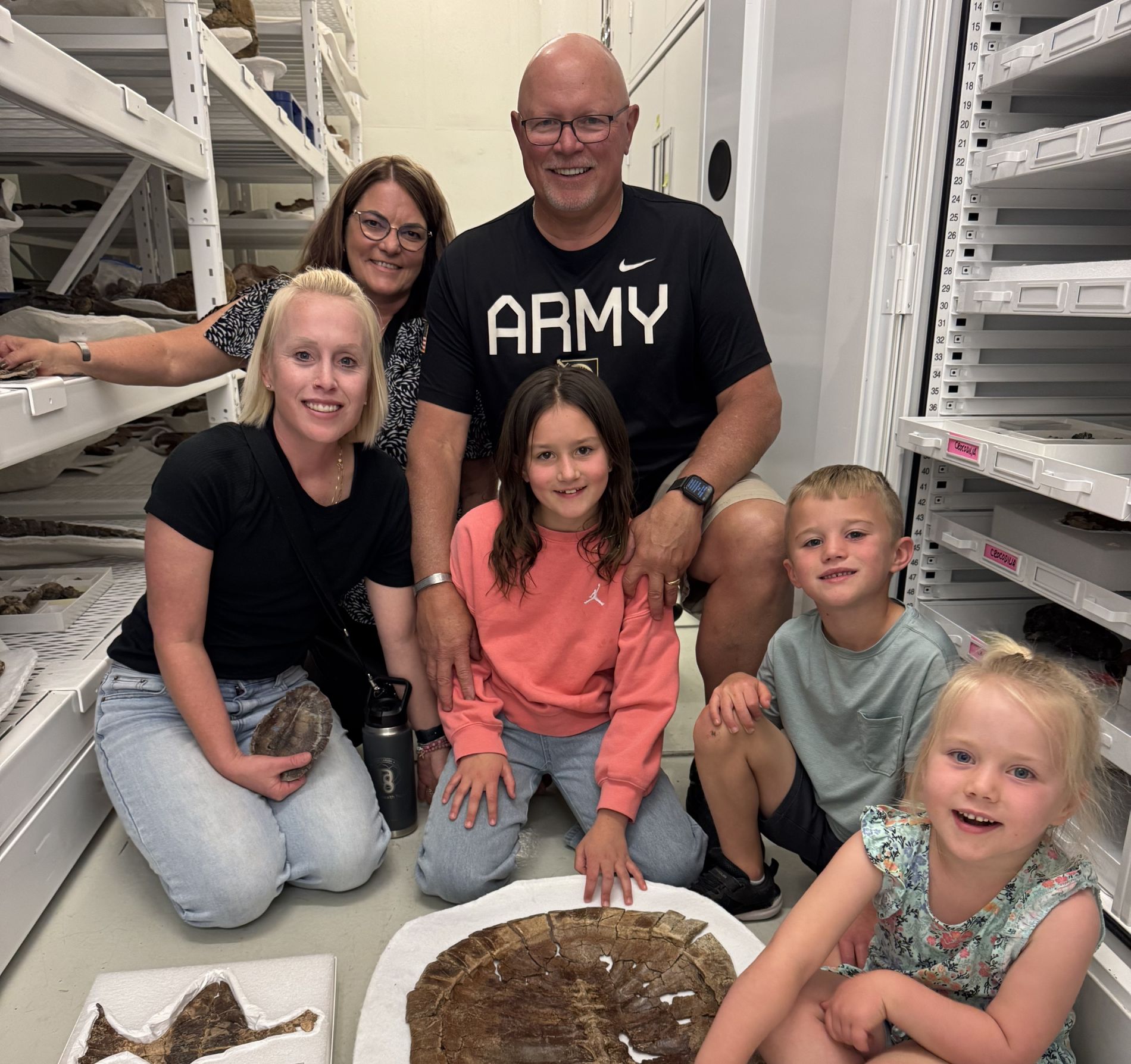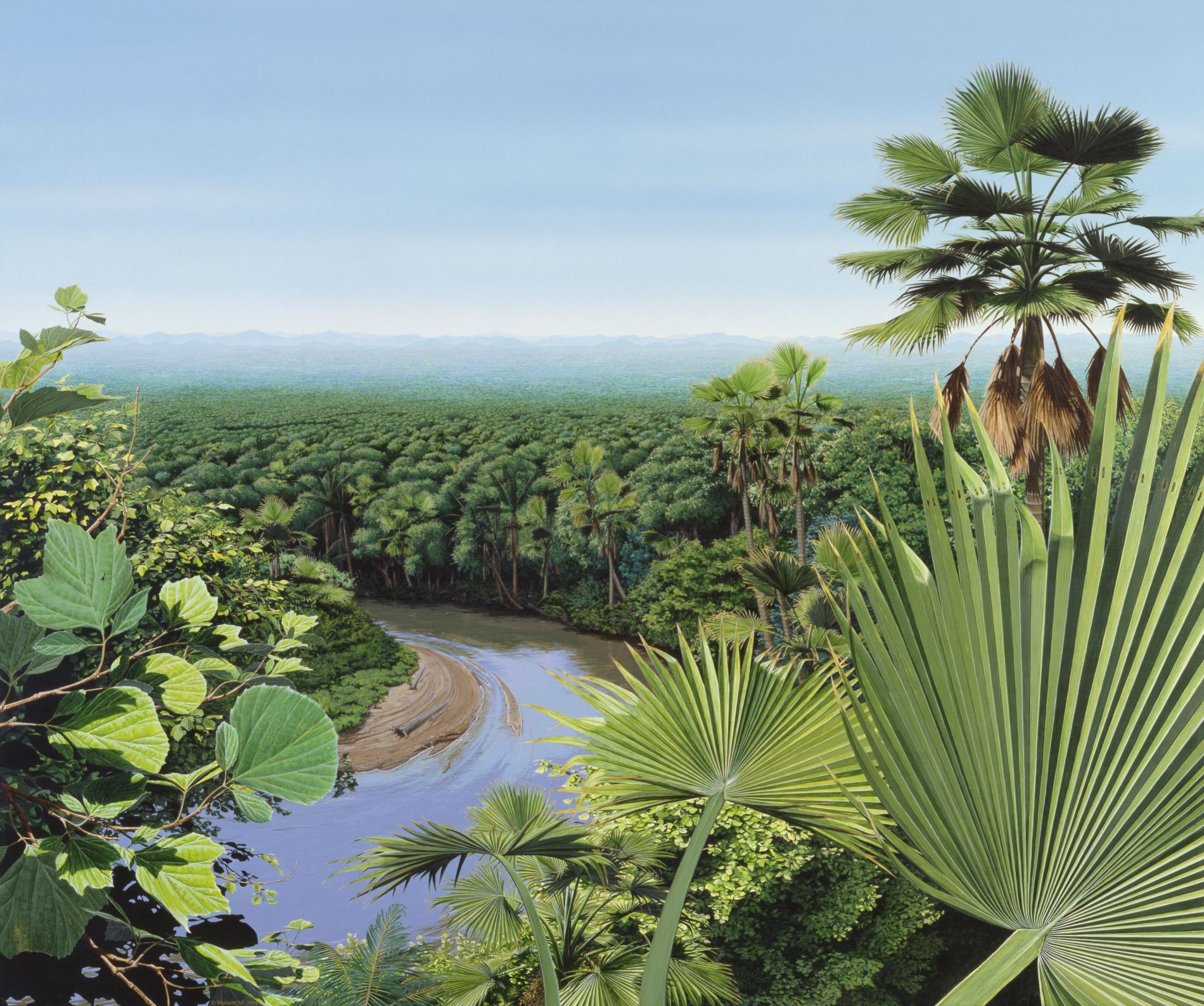CATALYST
DENVER MUSEUM OF NATURE & SCIENCE ONLINE MAGAZINE
Museum Scientists Discover Oldest Snapping Turtle Ever Found
This Ancient Species of Snapping Turtle Lived Just After the Dinosaurs Went Extinct

Reconstruction of Tavachelydra stevensoni, the oldest snapping turtle, basking on a log in a pond roughly 65.5 million years ago. (Illustration/ Andrey Atuchin)
If you go a few feet outside the Museum into City Park, you can find snapping turtles hanging out in the mud, waiting to munch down a fish or snack on an afternoon snail. Sometimes known as “mud dragons,” the common snapping turtle can live up to 100 years — but the latest discovery from the Denver Museum of Nature & Science scientists proves that their ancestors have been in Colorado for a lot longer than that.
The new species, named Tavachelydra stevensoni in honor of a close friend of Dr. Tyler Lyson, was found roughly 70 miles south of Denver at the Corral Bluffs field site on the outskirts of Colorado Springs. This is just the latest groundbreaking discovery made at the Corral Bluffs site by the Museum’s paleontology team.
Read more: A Tiny Mammal Reveals Clues About Life After the Dinosaurs

The Corral Bluffs field site is roughly 70 miles south of Denver on the outskirts of Colorado Springs. (Photo/ Rick Wicker)
The snapping turtle fossil was found in Sept. 2021 when Museum Postdoctoral Scholar Dr. Holger Petermann, who had been out traversing ridges in the bluffs, noticed fragments from what he initially thought was a baenid turtle shell, the most common species of turtle found in this field area.
Upon making the discovery, Dr. Petermann called over Dr. Tyler Lyson, the Museum’s senior curator of vertebrate paleontology and self-described “Turtle Guy,” who immediately identified the fossil as belonging to a type of snapping turtle, a very rare fossil specimen for paleontologists to uncover. Only fragments of snapping turtles had been found from this geologic interval, so Dr. Lyson recalled his immediate excitement upon seeing the fossil.

Museum Postdoctoral Scholar Dr. Holger Petermann in the field at Corral Bluffs in October 2021. (Photo/ Rick Wicker)
“Finding a snapping turtle fossil is very rare because they're so thin shelled compared to other turtles. When snapping turtles die, it all falls apart,” Dr. Lyson told Catalyst. “I’ve been looking for turtles for 30 years, and I can tell you that most turtle shell fragments are a dime a dozen. But snapping turtle shell fragments? They're really hard to find.”
After finding the shell fragments and determining its importance, the scientists immediately started searching out a “bone trail.” Luckily, they found one running up the side of the gully. They then followed that to where it ended and started to dig into the hillside.
“Soon after we started digging, we uncovered the plastron, or belly shell. This was another rare discovery because the top and bottom shell of snapping turtles don't fuse together. That means that for the two pieces to stay together, this turtle must have been buried relatively soon after death,” said Dr. Lyson.
Two field seasons later, former Museum Postdoctoral Scholar Emily Lessner, found a second snapping turtle carapace fossil from the same species in Corral Bluff in spring 2023. While less complete than the first specimen, the top shell, or carapace, was even better preserved than the original one. The team went on to publish an article describing the new snapping turtle species based on their fossils in the Swiss Journal of Palaeontology in August, 2025.

The topside of a fossil turtle shell of a newly named genus and species, Tavachelydra stevensoni, representing the world’s oldest known snapping turtle. (Photo/ Rick Wicker)
Honoring a Close Friend
Dr. Tyler Lyson named the snapping turtle Tavachelydra stevensoni in honor of Brandon D. Stevenson, who was both a close friend and a supporter of the project. Stevenson grew up with Dr. Tyler Lyson, attending high school and played sports together in Baker, Mont. Although life took them on separate journeys, the two stayed in touch as Stevenson joined the United States Military Academy and traveled all around the world, eventually settling down with his family in Colorado Springs.
When Dr. Lyson joined the Museum in 2014, he wanted to answer important scientific questions, and one of the biggest unanswered questions was what happened in the first million years after the giant dinosaurs went extinct – how and when did ecosystems rebuild after Earth’s last mass extinction event. Dr. Lyson was eager to look for the answers to those questions at the Corral Bluffs field site in part because of his personal connection to the area through his childhood friend, Stevenson.
“Honestly, that was one of the reasons I really wanted to get a field program going [at Corral Bluffs]. Because one, it's close, but two, it's always fun to spend time with people you enjoy seeing,” said Dr. Lyson.

The ancient snapping turtle Tavachelydra stevensoni was named in honor of Brandon D. Stevenson, a close friend of Dr. Lyson and a supporter of the field research.(Photo/ Wendy Stevenson)
Before making the groundbreaking mammal discoveries that would change our understanding of how life evolved following the extinction of the dinosaurs 66-million years ago, Dr. Lyson recalls relying on Stevenson for support and housing.
“Before we made the Corral Bluffs discoveries, I didn't have much money or the level of funding I do now. I was working with a bare bones budget. Brandon and his wife Wendy graciously offered to let me and my small team stay with them. I think I stayed with them at least 60 nights in 2016 and 2017. I may have overstayed my welcome,” said Dr. Lyson with a chuckle.
Dr. Lyson said that Stevenson and his family got to experience the joy of the incredible Corral Bluffs discoveries, in a way unlike anybody else.
“Every night, I'd come back to their home and tell them the story of whatever amazing fossil I had found that day and how mind-blowing every one of these discoveries was," he said. “They were both really, really excited about it all happening.”

Stevenson's family visiting the Museum to see the snapping turtle fossil named in their family member's honor in the Avenir Collection Center. (Photo/ Tyler Lyson)
Stevenson would accompany Dr. Lyson out into the field occasionally, often poking fun at his friend, saying things like “that's just a rock” or “how do you know that’s what you think it is?”
“[Brandon] was always very proud of the work I was doing, even though he was giving me [crap] about it,” said Dr. Lyson with a laugh.
Brandon and his family were at the Museum for the big unveiling of the “After the Asteroid” exhibition in 2019. Sadly, Brandon passed away in 2021. Since his passing, Dr. Lyson has remained close with his family, inviting them to the Museum to see the new species named in honor of their husband and father.
Snapping Turtles Go Back to the Time of Dinosaurs
So, what does this discovery fit into what we know about the evolution of turtles?
Dr. Lyson explains that while turtles aren’t the flashiest creatures, their simple, sturdy body plan has proven remarkably effective at weathering dramatic shifts in the planet’s climate and ecosystems. In fact, turtles have survived three of Earth’s last five mass extinctions.
According to Dr. Lyson, turtles had their body plan “figured out” more than 210 million years ago. By the time dinosaurs went extinct, turtles had already perfected a design that would carry them through one of the worst mass extinction events in Earth’s history —when about 75% of all species disappeared.
For comparison, Dr. Lyson said that during this same event, 93% of lizard species went extinct — but only one or two turtle species vanished. “If you only looked at turtles,” he says, “you wouldn’t even know there had been a mass extinction.”
Read more: What Happened to Lizards When the Dinosaurs Went Extinct?

"After Armageddon" from the Ancient Denvers series of paintings, 65 million years ago, Denver Formation. (Illustration/ Denver Museum of Nature & Science)
This new discovery marks the first known snapping turtle in the fossil record, adding another piece to the long evolutionary story that stretches back more than 150 million years before Tavachelydra stevensoni lived alongside our mammalian ancestors. Dr. Lyson now wants to find the snapping turtle fossils from the years before the dinosaurs went extinct, showing they lived at the same time when giant reptiles dominated the Earth.
What's next?
For Dr. Lyson, that’s an easy question to answer. The area outside of Corral Bluffs has already yielded several new species and provided a new window into the years directly following the death of the dinosaurs. Now, Dr. Lyson says, the Museum just needs to “go out and find more.”
Read more: Recorded in Stone: Single Worst Day for Multicellular Life on Earth
“Every spring and fall, we keep going out there to mine that area and we’re still shocked that we continue to find amazing fossils out there,” said Dr. Lyson. "For me, it's about doing more fieldwork and finding more fossils, because we've just scratched the surface.”
To make this discovery possible, fieldwork, preparation and research costs were supported by the National Science Foundation, M. L. and S. R. Kneller, and Lyda Hill Philanthropies. The fossils were donated to the Museum by the Norwood Development Group (Chris Jenkins).
Winter 2025
In This Edition
-
Celebrating 30 Years of Prehistoric Journey
The Exhibition You Grew Up with Is Still Full of New Discoveries
-
Surprising Symbiosis: Nature’s Unexpected Partnerships
Discover 5 Incredible Ways that Animals Coexist — Recreated with LEGO® Bricks
-
Museum Scientists Discover Oldest Snapping Turtle Ever Found
This Ancient Species of Snapping Turtle Lived Just After the Dinosaurs Went Extinct
-
Fueling Discovery: The Power of Individual Support and Federal Grants
The Behind-the-Scenes Support that Helps Make What We Do Possible
-
New Laws of Notion Release!
Institute for Science & Policy Latest Podcast Season Explores Wolf Reintroduction
Share this:
